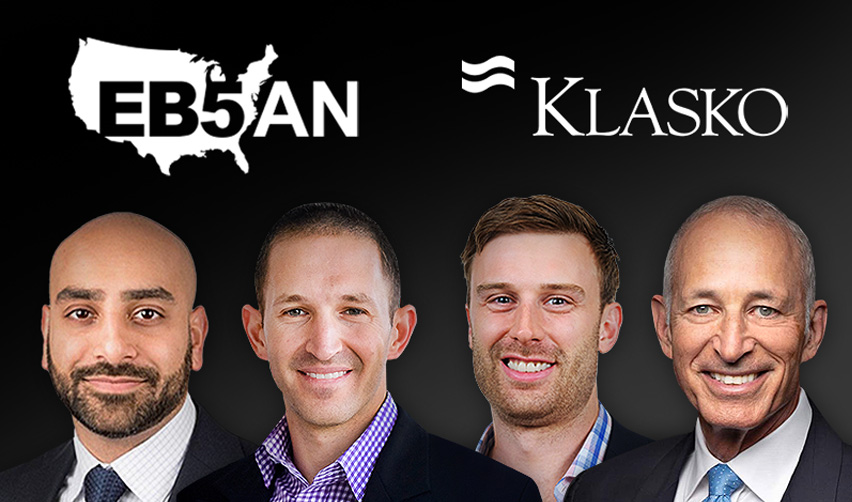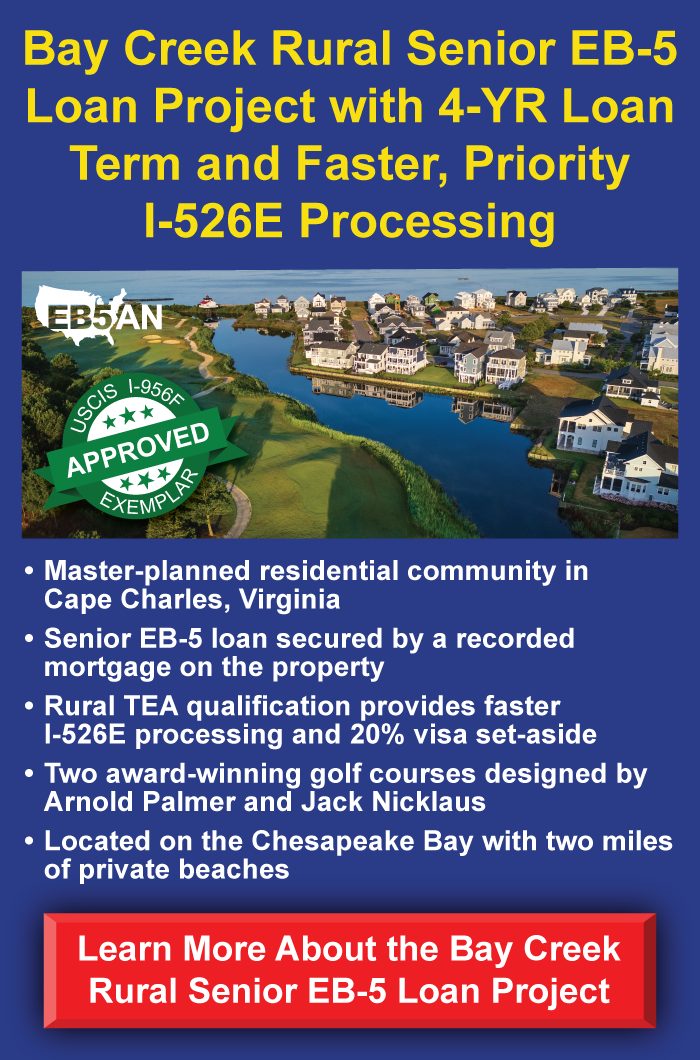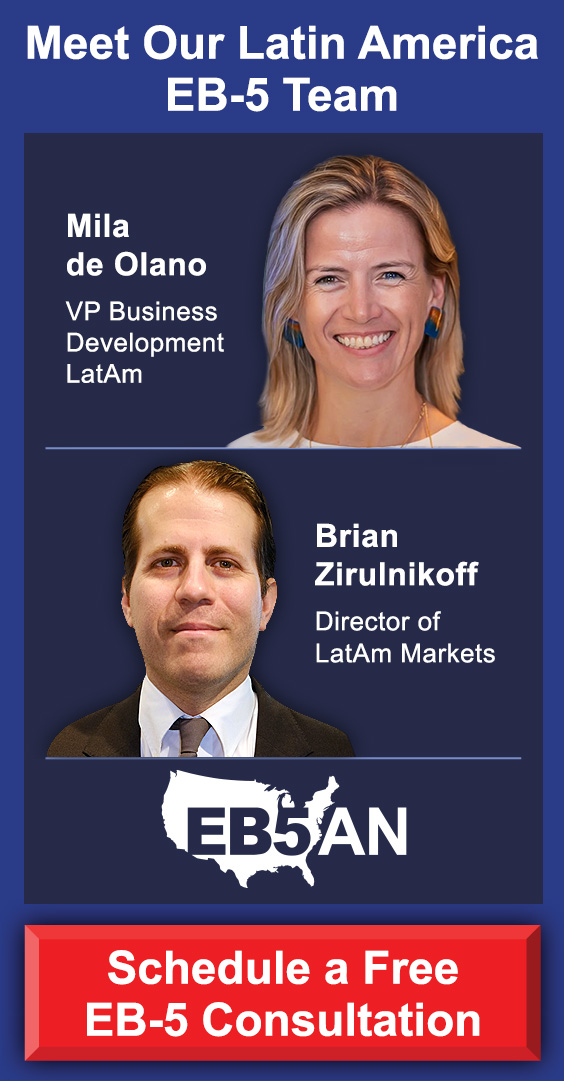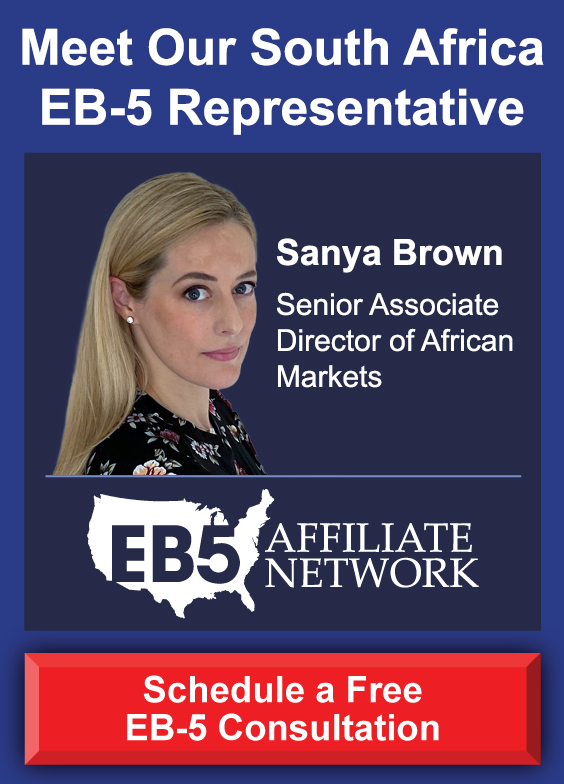On September 19, 2025, President Trump sent shockwaves through the U.S. immigration space with two major announcements: a new “Gold Card” program for permanent residency and a new fee of $100,000 for H-1B sponsors.
While there is much uncertainty as to how these policies will be implemented, both could significantly impact EB-5 and other existing immigration programs.
To help current and prospective EB-5 investors understand the potential outcomes of these executive orders, EB5AN hosted an informative webinar featuring H. Ronald Klasko, one of the leading immigration attorneys in the EB-5 industry.
As the founder and chairman of Klasko Immigration Law Partners, Ron has extensive experience in immigration law and EB-5 specifically. Klasko Partners is one of the largest immigration-only law firms in the U.S., and Ron has served as the national president of the American Immigration Lawyers Association and has chaired its EB-5 committee. He has also chaired the best practices committee of Invest in the USA, an EB-5 trade association.
Ron was joined by EB5AN managing partners Sam Silverman and Mike Schoenfeld, as well as EB5AN senior vice president and former immigration attorney Ahmed Khan.
If you have made or are planning an EB-5 investment—or are simply interested in exploring the immigration options available to you—this webinar offers actionable insights from some of the leading experts in U.S. immigration law. We invite you to watch the full webinar, its highlights, or to read the summary article below.
Select Webinar Highlights: The Trump Gold Card and New $100k Free for H-1B Visas
With Ron Klasko of Klasko Immigration Law Partners
Full Webinar: The Trump Gold Card and New $100k Free for H-1B Visas
With Ron Klasko of Klasko Immigration Law Partners
Overview of the Gold Card
The Gold Card vs. EB-5: Uncertainty and Risk for Trump’s New Program
Overview of the $100K Fee for H-1B Sponsors
EB-5 Offers Stability for H-1B Workers and a Way Around Backlogs for EB-2 Applicants
The EB-5 “Grandfathering” Deadline
Conclusion: What This Means for You
Overview of the Gold Card
President Trump’s introduction of the Gold Card program departs from the traditional legislative or regulatory process. Instead of creating a new category through conventional means, the administration has relied on executive orders and proclamations. This approach raises serious legal questions about whether the program is consistent with existing immigration law and whether it can withstand court challenges.
The same concerns apply to the recently announced $100,000 H-1B fee. Both measures bypass the normal channels, creating uncertainty about their legitimacy and long-term viability.
The Gold Card itself is presented as a $1 million donation to the U.S. government by an individual or a $2 million donation by a company on behalf of an employee.
Unlike the previously floated $5 million “Platinum Card” proposal, which included a worldwide tax exemption, the Gold Card carries the same global taxation obligations as any other Green Card.
To justify its legality, the administration has sought to fit Gold Card recipients into the existing EB-1 and EB-2 categories. The EB-2 national interest waiver is framed as being satisfied automatically by the donation. The EB-1 extraordinary ability classification, however, is more difficult to reconcile, as the ability to contribute funds does not equate to professional achievement or renown.
Notably, Gold Card holders would still be subject to the quota limits of the EB-1 and EB-2 categories. These categories already face significant backlogs, particularly for Indian and Chinese nationals. EB-1 currently carries long waits for applicants from India and China, and EB-2 backlogs are even more severe, with projections for Indian applicants stretching decades into the future.
Adding Gold Card applicants would only worsen these delays and potentially extend them worldwide. In contrast, the EB-5 program currently has no quota backlog for rural or high-unemployment projects, giving it a clear procedural advantage.
The cost structure also raises questions. While EB-5 requires a single $800,000 investment that covers the principal applicant and their immediate family, the Gold Card framework suggests a $1 million donation per Green Card holder. In other words, if applied literally, a family of four would be required to donate $4 million—$1 million for each family member.
Yet, under both EB-1 and EB-2 law, derivative family members automatically receive the same status without additional qualifying actions. How the Gold Card will be applied in practice therefore remains unclear, and guidance is expected only once implementation rules are published.
Another major difference stems from the immediate benefits tied to EB-5. EB-5 investors are eligible for concurrent filing, enabling them to obtain work and travel authorizations within months. This pathway offers tangible short-term security for families already in the United States.
By contrast, Gold Card applicants would face uncertainty over which agency will process their cases—as of now, we don’t know whether they will apply through the Department of Commerce or the Department of Homeland Security or how long adjudication will take. Moreover, even if processed, applicants from countries with high visa demand (China and India) would remain subject to lengthy backlogs, diminishing the program’s practical utility.
The Gold Card vs. EB-5: Uncertainty and Risk for Trump’s New Program
At first glance, the Gold Card announcement appeared to offer an appealing alternative, assuming it could be implemented despite potential legal challenges. However, forcing the program into the structure of the EB-1 and EB-2 categories raises significant concerns.
As a result, for most investors, the Gold Card program does not compare favorably to EB-5.
One area of confusion has been whether the Gold Card would avoid the rigorous source and path of funds review required in EB-5. Despite early speculation, it is highly unlikely that the government would allow applicants to bypass proving the lawful origin of their capital. To do so would effectively signal that unlawful funds could be used to purchase immigration benefits, a position that is undesirable and unsustainable. Investors should therefore expect the same demanding documentation standards under the Gold Card as under EB-5, limiting its relative simplicity.
The Gold Card does carry one potential advantage: It eliminates conditional residence. Unlike EB-5, Gold Card donors would not receive a two-year conditional Green Card followed by the need to file an I-829 petition to remove the conditions on their residency. This alternative timeline could appeal to some applicants.
Still, the Gold Card is highly vulnerable to federal court challenges. Because it relies solely on executive action, a court could rule that it unlawfully attempts to alter the EB-1 and EB-2 categories without statutory authority. If that happens, participants would be left with no immigration benefit after having made a non-refundable $1 million donation.
Put simply, unlike EB-5, which is a law passed by Congress and protected by statutory grandfathering, the Gold Card could be rescinded by litigation or by a change in administration, and anyone who participated in the program could be left without U.S. residency and their donation.
There are also differences in the financial structure of both programs. At its core, EB-5 is an investment. EB-5 investors can therefore have their original capital returned to them if the project performs successfully—with the chance of receiving additional returns as well.
The Gold Card, meanwhile, is a donation. Donors would have no expectation of recovering any portion of their funds. They are, in essence, buying their Gold Card.
In addition, as mentioned earlier, EB-5 permits targeted investments of $800,000 that cover the principal applicant and their immediate family. The Gold Card’s structure suggests $1 million per individual Green Card, though how this will be reconciled with the derivative status under EB-1 and EB-2 remains unclear.
The tax treatment further diminishes the appeal of the Gold Card. Early discussions around a $5 million “Platinum Card” proposal had suggested exemption from U.S. worldwide taxation, but that feature has been abandoned. Gold Card holders would be subject to the same global income taxation as any other permanent resident.
For certain investors, however, the Gold Card may still hold some appeal. It removes the element of the “at-risk” investment required in EB-5. Investors unwilling to accept the possibility of loss associated with EB-5 projects may prefer the certainty of a straightforward donation—though they would also have to accept that there is no possibility of receiving their donation back.
The Gold Card also avoids the uncertainty of the I-829 process, where job creation must be proven several years after the initial investment.
Finally, the administration has promised expedited processing for Gold Card donors—though what “expedited” will mean in practice is undefined and may not exceed the speed of EB-5 priority processing.
Realistically, the narrow set of individuals for whom the Gold Card might make sense are those outside India and China—given the severe backlogs in EB-1 and EB-2 for those countries—who possess significant wealth beyond the required $1 million and who place an extremely high premium on immediate certainty.
Even for such applicants, the Gold Card carries the substantial legal risk that federal courts could invalidate it entirely. Because executive orders can be undone with the same stroke by a new administration, and because any challenge could eliminate the program after donations are made, the risk profile remains exceptionally high.
Due to these complications, the Gold Card proposal is viewed by many industry stakeholders as a rushed product. It faces clear legal vulnerabilities, lacks meaningful advantages over EB-5, and is unlikely to attract serious uptake from investors aware of the risks. This raises the question of what the administration’s real objective might be in creating the Gold Card.
One interpretation is that the administration initially sought to enact the earlier $5 million version of the Gold Card—now referred to as the Platinum Card—through the budget reconciliation process. That attempt appears to have failed due to strong opposition in Congress.
Lawmakers objected to the idea of creating a mechanism for wealthy individuals to purchase immigration benefits and, in the case of the Platinum Card, obtain exemption from worldwide taxation. Allowing a small group of foreign nationals to avoid U.S. tax obligations while American citizens remain fully subject to them generated intense controversy. The likely requirement of an Internal Revenue Code amendment further complicated that effort.
Unable to achieve legislative approval, the administration shifted to executive action as a means of forcing the issue.
Underlying these efforts appears to be a consistent goal: It seems the Trump administration wishes to make U.S. immigration based on wealth rather than other criteria. Interestingly, EB-5 seems to fit this goal remarkably well.
EB-5 has long aligned with the policy priorities often emphasized by the Trump administration, particularly the focus on investment-driven immigration and U.S. job creation. More than any other category, EB-5 directly ties U.S. residency to substantial economic contributions, making it consistent with the broader emphasis on wealth and capital as the basis for immigration benefits.
The program’s impact on the U.S. economy is well established. EB-5 channels capital into development projects, creating jobs for American workers and sustaining growth, even during times of financial stress. Its value was particularly visible during the 2008 financial crisis, when traditional sources of financing dried up. At that time, EB-5 capital became crucial for U.S. developers, allowing stalled projects to continue and keeping construction and employment moving forward.
While the concept of granting residency through direct financial contributions is not unprecedented—other countries have experimented with donation-based programs—the U.S. already has a proven record of success for such a program in EB-5, a program which has clear benefits beyond just the investors receiving Green Cards and the projects receiving capital.
Overview of the $100K Fee for H-1B Sponsors
The proposed $100,000 H-1B requirement also leaves major questions unanswered.
The executive order was released abruptly, announced late on a Friday and made “effective” by midnight the following day. This caused confusion and even panic, with reports of H-1B workers attempting to reenter the United States before the deadline to avoid the fee. The following days saw clarifications, guidance memos, and press statements that walked back parts of the announcement without solving the core uncertainties.
The key point appears to be that obtaining or using an H-1B visa would require a $100,000 payment from the sponsoring employer. It’s unclear whether the fee applies to existing H-1B holders, to changes of status from student to H-1B, to extensions with the same employer, or to transfers between employers.
Legal challenges are almost certain for this policy. The administration has invoked Section 212(f) of the Immigration and Nationality Act, which grants the president authority to restrict entry into the United States. But this authority is limited to entry—it cannot regulate individuals already inside the country, nor can it govern changes of status or extensions of stay. That limitation undermines the proposed rule’s scope.
Additionally, the nature of the $100,000 payment raises problems. Immigration fees must reflect the costs of adjudication. Because no adjudication costs could justify such an amount, it cannot be legally classified as a fee. If it is a tax, then Congress alone holds taxing power, and an executive order cannot create it.
What is more, there is no mechanism for paying this new fee. The logical assumption would be that the State Department, which oversees visa issuance abroad, would serve this role. But the agency the administration seems likely to task with this role is actually the Department of Homeland Security, which has no role in consular processing—making this a confusing choice should the department gain this responsibility.
Beyond legality and procedure, the proposal conflicts with broader economic interests. Requiring $100,000 for each H-1B visa would discourage U.S. companies from hiring foreign professionals and incentivize them to offshore or outsource these roles. Rather than strengthening the domestic labor market, the rule would risk weakening U.S. competitiveness by making skilled hiring prohibitively expensive.
EB-5 Offers Stability for H-1B Workers and a Way Around Backlogs for EB-2 Applicants
In recent years, EB-5 has become a more popular pathway for foreign nationals in the United States, particularly H-1B holders, seeking Green Cards. Many have turned to EB-5 not only for its immediate benefits, such as employment and travel authorization through concurrent filing, but also for a clear path to permanent residency.
For those trapped in the EB-2 backlog—especially applicants with priority dates after 2017—the chances of receiving a Green Card within their lifetime is very low. Applicants have therefore opted for the much faster EB-5 route, with some recent EB-5 petitions being approved in only five months.
Overall, EB-5 offers these foreign nationals an alternative that is both practical and secure. Unlike the speculative nature of the Gold Card or the instability of the H-1B system, EB-5 is current, functioning, and backed by the law.
The EB-5 “Grandfathering” Deadline
The introduction of the Gold Card has prompted some investors to explore it as an alternative, but the consensus is that EB-5 remains the stronger option. In fact, demand for EB-5 is expected to grow in the coming year as the program approaches a critical deadline.
EB-5 operates under two key timelines. The first is the expiration of the regional center program itself, which is set for September 30, 2027. Historically, Congress has renewed the program through periodic extensions, and stakeholders in the EB-5 industry continue to advocate for an early and stable reauthorization to avoid last-minute uncertainty.
The second is the grandfathering date, set as September 30, 2026. The grandfathering provision established by the EB-5 Reform and Integrity Act ensures that any investor who files an EB-5 petition by this date will remain eligible to complete the process and obtain a Green Card, even if the regional center program is not reauthorized beyond its current expiration date.
The practical effect is that many investors will want to file before the 2026 deadline.
Preparing an EB-5 petition, though, is not always straightforward. It requires time to assemble funds, document lawful sources of capital, and gather the necessary evidence for filing. For individuals who begin exploring EB-5 now, it may take months to prepare their I-526Es. And as the deadline approaches, we expect a surge in EB-5 filings, meaning the process may become stalled and take longer than expected.
For these reasons, we suggest that all prospective investors act fast to ensure they can file before the approaching deadline.
Conclusion: What This Means for You
While the Gold Card and $100,000 H-1B fee could come into effect, they remain legally vulnerable and uncertain. Conversely, EB-5 remains a stable, codified program with defined rules, clear benefits, and a proven track record of supporting both immigrant families and the U.S. economy.
To evaluate the best immigration options for you and your family, we encourage you to work with an experienced immigration law firm like Klasko Immigration Law Partners. And if EB-5 is your choice, we invite you to schedule a free consultation with EB5AN and get started on the path to a U.S. Green Card.







